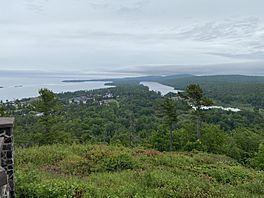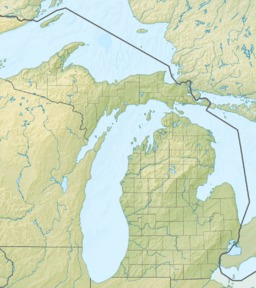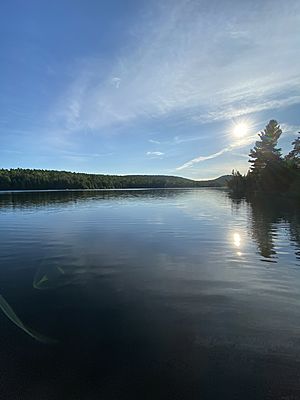Lake Fanny Hooe facts for kids
Quick facts for kids Lake Fanny Hooe |
|
|---|---|

Lake Fanny Hooe in the middle right of the image
|
|
| Location | Grant Township, Keweenaw County, Michigan |
| Coordinates | 47°27′51″N 87°51′47″W / 47.4640285°N 87.8630852°W |
| Surface area | 227 acres (92 ha) |
| Max. depth | 40 feet (12 m) |
| Surface elevation | 620 feet (190 m) |
| Settlements | Copper Harbor |
Lake Fanny Hooe is a beautiful lake located in Keweenaw County, Michigan. It covers about 227 acres, which is like 170 football fields! This lake is a great spot for nature lovers and history buffs.
Contents
Discovering Lake Fanny Hooe
Lake Fanny Hooe is a special place. It offers a mix of natural beauty and interesting history. The lake is known for its clear waters and peaceful surroundings.
Where is Lake Fanny Hooe?
This lovely lake is found in the northern part of Michigan. It is in Grant Township, Keweenaw County, Michigan. The small community of Copper Harbor is located on the northwest side of the lake. This makes it easy for visitors to explore both the town and the lake.
A Link to Lake Superior
Lake Fanny Hooe is connected to one of the Great Lakes. A small stream called the Garden Brook flows from Lake Fanny Hooe. This brook travels about 800 feet north. It then empties into Lake Superior. This connection means that water from Lake Fanny Hooe eventually reaches the largest of the Great Lakes.
Exploring Fort Wilkins Historic State Park
One of the most exciting features near Lake Fanny Hooe is Fort Wilkins Historic State Park. This park is right between Lake Fanny Hooe and Lake Superior. It's a fantastic place to learn about Michigan's past.
What is Fort Wilkins?
Fort Wilkins was a U.S. Army fort. It was built way back in 1844. The fort was important for keeping peace in the area. It also helped protect the copper mining industry. Today, you can visit the fort and see how soldiers lived.
A Glimpse into History
At Fort Wilkins, you can explore old buildings. There are barracks, officers' quarters, and other historic structures. Costumed interpreters often show what life was like in the 1840s. It's like stepping back in time! The park helps visitors understand the history of the region.




